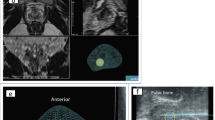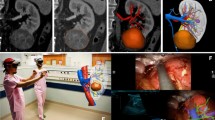Abstract
Context
Large and complex renal stones are usually treated with percutaneous nephrolithotomy (PCNL). One of the crucial steps in this procedure is the access to the collecting system with the percutaneous puncture and this maneuver leads to a risk of vascular and neighboring organs’ injury. In the last years, the application of virtual image-guided surgery has gained wide diffusion even in this specific field.
Objectives
To provide a short overview of the most recent evidence on current applications of virtual imaging guidance for PCNL.
Evidence acquisition
A non-systematic review of the literature was performed. Medline, PubMed, the Cochrane Database and Embase were screened for studies regarding the use virtual imaging guidance for PCNL.
Evidence synthesis
3D virtual navigation technology for PCNL was first used in urology with the purpose of surgical training and surgical planning; subsequently, the field of surgical navigation with different modalities (from cognitive to augmented reality or mixed reality) had been explored. Finally, anecdotal preliminary experiences explored the potential application of artificial intelligence guidance for percutaneous puncture.
Conclusion
Nowadays, many experiences proved the potential benefit of virtual guidance for surgical simulation and training. Focusing on surgery, this tool revealed to be useful both for surgical planning, allowed to achieve a better surgical performance, and for surgical navigation by using augmented reality and mixed reality systems aimed to assist the surgeon in real time during the intervention.



Similar content being viewed by others
References
Türk C, Petřík A, Sarica K et al (2016) EAU guidelines on interventional treatment for urolithiasis. Eur Urol 69(3):475–482. https://doi.org/10.1016/j.eururo.2015.07.041
Stern KL, Sivalingam S (2018) Retrograde intrarenal surgery versus percutaneous surgery: do we have a winner? Minerva Urol Nefrol 70(1):4–5. https://doi.org/10.23736/S0393-2249.17.03036-3
Hang B, Xie H, Hu Y, Liu C (2019) The visual percutaneous nephrolithotomy versus the conventional percutaneous nephrolithotomy in treatment for renal stone. Minerva Urol Nefrol 71(6):627–635. https://doi.org/10.23736/S0393-2249.19.03465-9
Porpiglia F, Cossu M, Poggio M et al (2015) 701 Endoscopic combined intra renal surgery (ECIRS): 10 years of experience. Eur Urol Suppl 14(2):e701. https://doi.org/10.1016/S1569-9056(15)60693-5
Kallidonis P, Kyriazis I, Kotsiris D, Koutava A, Kamal W, Liatsikos E (2017) Papillary vs nonpapillary puncture in percutaneous nephrolithotomy: a prospective randomized trial. J Endourol 31(S1):S4–S9
Kyriazis I, Kallidonis P, Vasilas M, Panagopoulos V, Kamal W, Liatsikos E (2017) Challenging the wisdom of puncture at the calyceal fornix in percutaneous nephrolithotripsy: feasibility and safety study with 137 patients operated via a non-calyceal percutaneous track. World J Urol 35(5):795–801
Kallidonis P, Kalogeropoulou C, Kyriazis I, Apostolopoulos D, Kitrou P, Kotsiris D et al (2017) Percutaneous nephrolithotomy puncture and tract dilation: evidence on the safety of approaches to the infundibulum of the middle renal calyx. Urology 107:43–48
de la Rosette J, Assimos D, Desai M, Gutierrez J, Lingeman J, Scarpa R et al (2011) The Clinical Research Office of the Endourological Society Percutaneous Nephrolithotomy Global Study: indications, complications, and outcomes in 5803 patients. J Endourol 25(1):11–17
Kim HY, Lee KW, Lee DS (2020) Critical causes in severe bleeding requiring angioembolization after percutaneous nephrolithotomy. BMC Urol 20(1):22
Veneziano D, Amparore D, Cacciamani G, Porpiglia F, Uro-technology; SoMe Working Group of the Young Academic Urologists Working Party of the European Association of Urology; European Section of Uro-Technology (2020) Climbing over the barriers of current imaging technology in urology. Eur Urol 77(2):142–143. https://doi.org/10.1016/j.eururo.2019.09.016 (Epub 2019 Oct 12. PMID: 31610902)
Portelli M, Bianco SF, Bezzina T, Abela JE (2020) Virtual reality training compared with apprenticeship training in laparoscopic surgery: a meta-analysis. Ann R Coll Surg Engl 102(9):672–684. https://doi.org/10.1308/rcsann.2020.0178 (Epub 2020 Aug 21. PMID: 32820649; PMCID: PMC7591600)
Farcas M, Reynolds LF, Lee JY (2021) Simulation-based percutaneous renal access training: evaluating a novel 3D immersive virtual reality platform. J Endourol. https://doi.org/10.1089/end.2020.0674 (Epub ahead of print. PMID: 33261507)
Veneziano D, Smith A, Reihsen T, Speich J, Sweet RM (2015) The SimPORTAL fluoro-less C-arm trainer: an innovative device for percutaneous kidney access. J Endourol 29(2):240–245. https://doi.org/10.1089/end.2014.0401 (Epub 2014 Oct 30 PMID: 25177777)
Parkhomenko E, O’Leary M, Safiullah S, Walia S, Owyong M, Lin C, James R, Okhunov Z, Patel RM, Kaler KS, Landman J, Clayman R (2019) Pilot assessment of immersive virtual reality renal models as an educational and preoperative planning tool for percutaneous nephrolithotomy. J Endourol 33(4):283–288. https://doi.org/10.1089/end.2018.0626 (Epub 2018 Dec 21 PMID: 30460860)
Li H, Chen Y, Liu C, Li B, Xu K, Bao S (2013) Construction of a three-dimensional model of renal stones: comprehensive planning for percutaneous nephrolithotomy and assistance in surgery. World J Urol 31(6):1587–1592. https://doi.org/10.1007/s00345-012-0998-7 (Epub 2012 Dec 8 PMID: 23223963)
Amparore D, Pecoraro A, Checcucci E, DE Cillis S, Piramide F, Volpi G, Piana A, Verri P, Granato S, Sica M, Manfredi M, Fiori C, Autorino R, Porpiglia F (2021) 3D imaging technologies in minimally-invasive kidney and prostate cancer surgery: which is the urologists' perception? Minerva Urol Nephrol. https://doi.org/10.23736/S2724-6051.21.04131-X
Rassweiler JJ, Müller M, Fangerau M, Klein J, Goezen AS, Pereira P, Meinzer HP, Teber D (2012) iPad-assisted percutaneous access to the kidney using marker-based navigation: initial clinical experience. Eur Urol 61(3):628–631. https://doi.org/10.1016/j.eururo.2011.12.024 (Epub 2011 Dec 21 PMID: 22209052)
Müller M, Rassweiler MC, Klein J, Seitel A, Gondan M, Baumhauer M, Teber D, Rassweiler JJ, Meinzer HP, Maier-Hein L (2013) Mobile augmented reality for computer-assisted percutaneous nephrolithotomy. Int J Comput Assist Radiol Surg 8(4):663–675. https://doi.org/10.1007/s11548-013-0828-4 (Epub 2013 Mar 23 PMID: 23526436)
Mozer P, Conort P, Leroy A et al (2007) Aid to percutaneous renal access by virtual projection of the ultrasound puncture tract onto fluoroscopic images. J Endourol 21(5):460–465. https://doi.org/10.1089/end.2006.0168
Oliveira-Santos T, Peterhans M, Roth B et al (2010) Computer aided surgery for percutaneous nephrolithotomy: clinical requirement analysis and system design. Annu Int Conf IEEE Eng Med Biol Soc 2010:442–445. https://doi.org/10.1109/IEMBS.2010.5627387
Su L-M, Stoianovici D, Jarrett TW et al (2002) Robotic percutaneous access to the kidney: comparison with standard manual access. J Endourol 16(7):471–475. https://doi.org/10.1089/089277902760367421
Rodrigues PL, Vilaca JL, Oliveira C et al (2013) Collecting system percutaneous access using real-time tracking sensors: first pig model in vivo experience. J Urol 190(5):1932–1937. https://doi.org/10.1016/j.juro.2013.05.042
Pollock R, Mozer P, Guzzo TJ et al (2010) Prospects in percutaneous ablative targeting: comparison of a computer-assisted navigation system and the AcuBot Robotic System. J Endourol 24(8):1269–1272. https://doi.org/10.1089/end.2009.0482
Ritter M, Rassweiler M-C, Hacker A, Michel MS (2013) Laser-guided percutaneous kidney access with the Uro Dyna-CT: first experience of three-dimensional puncture planning with an ex vivo model. World J Urol 31(5):1147–1151. https://doi.org/10.1007/s00345-012-0847-8
Akand M, Civcik L, Buyukaslan A et al (2019) Feasibility of a novel technique using 3-dimensional modeling and augmented reality for access during percutaneous nephrolithotomy in two different ex-vivo models. Int Urol Nephrol 51(1):17–25. https://doi.org/10.1007/s11255-018-2037-0
Rassweiler-Seyfried M-C, Rassweiler JJ, Weiss C et al (2019) iPad-assisted percutaneous nephrolithotomy (PCNL): a matched pair analysis compared to standard PCNL. World J Urol. https://doi.org/10.1007/s00345-019-02801-y
Porpiglia F, Checcucci E, Amparore D, Peretti D, Piramide F, DeCillis S, Verri P, Niculescu RG, Poggio M, Cossu M, Fiori C (2020) Kidney stones surgical treatment with 3 D mixed reality assistance for percutaneous puncture. J Urol 203(Supplement 4):e387
Checcucci E, Autorino R, Cacciamani GE, Amparore D, De Cillis S, Piana A, Piazzolla P, Vezzetti E, Fiori C, Veneziano D, Tewari A, Dasgupta P, Hung A, Gill I, Porpiglia F, Uro-technology and SoMe Working Group of the Young Academic Urologists Working Party of the European Association of Urology (2020) Artificial intelligence and neural networks in urology: current clinical applications. Minerva Urol Nefrol 72(1):49–57. https://doi.org/10.23736/S0393-2249.19.03613-0 (Epub 2019 Dec 12. PMID: 31833725)
Checcucci E, De Cillis S, Granato S, Chang P, Afyouni AS, Okhunov Z, Uro-Technology and SoMe Working Group of the Young Academic Urologists Working Party of the European Association of Urology (2020) Applications of neural networks in urology: a systematic review. Curr Opin Urol 30(6):788–807. https://doi.org/10.1097/MOU.0000000000000814 (PMID: 32881726)
Yang B, Veneziano D, Somani BK (2020) Artificial intelligence in the diagnosis, treatment and prevention of urinary stones. Curr Opin Urol 30(6):782–787. https://doi.org/10.1097/MOU.0000000000000820 (PMID: 32941256)
Hatt CR, Ng G, Parthasarathy V (2015) Enhanced needle localization in ultrasound using beam steering and learning-based segmentation. Comput Med Imaging Graph 41:46–54. https://doi.org/10.1016/j.compmedimag.2014.06.016 (Epub 2014 Jul 6 PMID: 25063736)
Mathiassen K, Dallalba D, Muradore R, Fiorini P, Elle OJ (2017) Robust real-time needle tracking in 2-D ultrasound images using statistical filtering. IEEE Trans Control Syst Technol 25(3):966–978. https://doi.org/10.1109/TCST.2016.2587733
Beigi P, Rohling R, Salcudean SE, Ng GC (2017) CASPER: computer-aided segmentation of imperceptible motion-a learning-based tracking of an invisible needle in ultrasound. Int J Comput Assist Radiol Surg 12(11):1857–1866. https://doi.org/10.1007/s11548-017-1631-4 (Epub 2017 Jun 24 PMID: 28647883)
Mwikirize C, Nosher JL, Hacihaliloglu I (2018) Convolution neural networks for real-time needle detection and localization in 2D ultrasound. Int J Comput Assist Radiol Surg 13(5):647–657. https://doi.org/10.1007/s11548-018-1721-y (Epub 2018 Mar 6 PMID: 29512006)
Lee JY, Islam M, Woh JR, Washeem TSM, Ngoh LYC, Wong WK, Ren H (2020) Ultrasound needle segmentation and trajectory prediction using excitation network. Int J Comput Assist Radiol Surg 15(3):437–443. https://doi.org/10.1007/s11548-019-02113-x (Epub 2020 Jan 20 PMID: 31960247)
Author information
Authors and Affiliations
Contributions
Protocol/project development: EC, DA, GC, JGR; data collection or management: SDC, AP, AT; data analysis: SP, DZ, JM, BC, AP; manuscript writing/editing: EC, GV; supervision: CF, MM, SDL, EL, FP.
Corresponding author
Ethics declarations
Conflict of interest
All the authors have nothing to disclose.
Research involving human participants and/or animals
None.
Informed consent
None.
Additional information
Publisher's Note
Springer Nature remains neutral with regard to jurisdictional claims in published maps and institutional affiliations.
Rights and permissions
About this article
Cite this article
Checcucci, E., Amparore, D., Volpi, G. et al. Percutaneous puncture during PCNL: new perspective for the future with virtual imaging guidance. World J Urol 40, 639–650 (2022). https://doi.org/10.1007/s00345-021-03820-4
Received:
Accepted:
Published:
Issue Date:
DOI: https://doi.org/10.1007/s00345-021-03820-4




